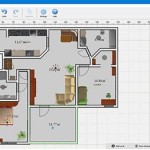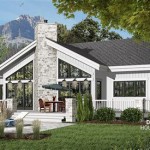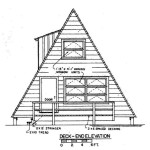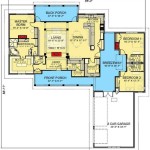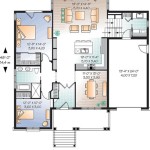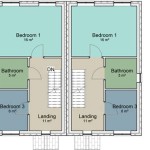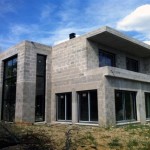House Plans For Sloping Lots are architectural designs specifically engineered to accommodate the unique challenges posed by building on a sloped terrain. These plans carefully consider factors such as drainage, retaining walls, and proper foundation designs to ensure structural stability and aesthetic appeal in sloping environments. An example of such a plan might involve a split-level home with multiple floors staggered along the slope, maximizing natural light and views while minimizing excavation costs.
Designing a home on a sloping lot requires meticulous planning and attention to detail. House Plans For Sloping Lots provide a framework for achieving a functional and visually stunning outcome. In the following sections, we will delve into the intricacies of these plans, exploring their advantages, challenges, and the key considerations involved in selecting and implementing them for a successful sloping lot development.
House Plans For Sloping Lots encompass several key considerations to ensure structural integrity and aesthetic appeal on challenging terrain:
- Drainage Management
- Retaining Walls
- Foundation Design
- Split-Level Designs
- Natural Light Optimization
- Views Maximization
- Excavation Minimization
- Building Codes Compliance
- Geotechnical Analysis
- Landscaping Integration
By addressing these factors, House Plans For Sloping Lots enable the creation of homes that are both functional and visually stunning in sloping environments.
Drainage Management
Proper drainage management is crucial for House Plans For Sloping Lots to prevent water accumulation, erosion, and structural damage. It involves carefully directing rainwater and runoff away from the foundation and surrounding areas.
- Gutter and Downspout Systems
Gutters and downspouts collect rainwater from the roof and channel it away from the foundation. They should be regularly cleaned and maintained to ensure proper drainage.
- French Drains
French drains are underground perforated pipes surrounded by gravel that collect and redirect groundwater away from the foundation. They are particularly effective in areas with high water tables.
- Grading and Sloping
Grading and sloping the land around the house directs water away from the foundation. The ground should be sloped away from the house with a minimum of 6 inches of fall for every 10 feet.
- Sump Pumps
Sump pumps are used in areas with poor drainage or high water tables. They collect water that seeps into the basement or crawlspace and pump it away from the house.
Effective drainage management is essential for the longevity and structural integrity of homes built on sloping lots. By implementing proper drainage systems, homeowners can protect their property from water damage and ensure a healthy and comfortable living environment.
Retaining Walls
Retaining walls are essential structural elements in House Plans For Sloping Lots, designed to support soil and prevent erosion on sloped terrain. They provide stability to the foundation and enhance the overall aesthetics of the property.
- Soil Retention
Retaining walls hold back soil and prevent it from sliding down the slope, ensuring the stability of the foundation and surrounding areas.
- Erosion Control
Retaining walls act as barriers against water erosion, preventing soil loss and protecting the integrity of the slope.
- Leveling and Terracing
Retaining walls can be used to create level areas on sloping lots, allowing for the construction of patios, decks, or additional living spaces.
- Aesthetic Enhancement
Retaining walls can enhance the visual appeal of a sloping property, adding texture, dimension, and architectural interest.
Retaining walls are an important consideration in House Plans For Sloping Lots, ensuring structural stability, erosion control, and aesthetic enhancement. By carefully designing and constructing retaining walls, homeowners can create safe and visually stunning outdoor spaces on challenging terrain.
Foundation Design
Foundation design is a critical aspect of House Plans For Sloping Lots, as it ensures the structural integrity and stability of the home on uneven terrain. Sloped lots often require specialized foundation systems to accommodate the unique challenges posed by the terrain.
One common foundation type for sloping lots is the stepped footing foundation. Stepped footings are a series of concrete pads that are placed at different elevations along the slope. The pads are connected by concrete beams or walls, creating a stepped effect that follows the contour of the land. This type of foundation provides a stable base for the home and helps to distribute the weight of the structure evenly across the slope.
Another option for sloping lots is a pier and beam foundation. Pier and beam foundations consist of concrete piers that are sunk into the ground and support wooden beams. The beams are then used to frame the floor of the home. This type of foundation is particularly well-suited for slopes with poor soil conditions or areas with high water tables, as it elevates the home above the ground and reduces the risk of water damage.
In some cases, a combination of foundation types may be used to create a hybrid foundation system. For example, a stepped footing foundation may be used in conjunction with a pier and beam foundation to provide a stable base for the home while also elevating it above the ground. The choice of foundation system for a sloping lot will depend on factors such as the slope of the land, the soil conditions, and the size and weight of the home.
Proper foundation design is essential for the safety and longevity of homes built on sloping lots. By carefully selecting and constructing a foundation system that is appropriate for the specific conditions of the site, homeowners can ensure that their home is structurally sound and able to withstand the challenges of sloping terrain.
Split-Level Designs
Split-level designs are a popular choice for House Plans For Sloping Lots as they allow for creative and functional use of space on uneven terrain. Split-level homes are characterized by their staggered floor levels, which are connected by short flights of stairs. This design approach offers several advantages for sloping lots.
One advantage of split-level designs is that they allow for the creation of multiple living spaces on different levels. For example, the main living areas, such as the living room, dining room, and kitchen, can be located on the upper level to take advantage of natural light and views. The lower level can be used for more private spaces, such as bedrooms, bathrooms, and family rooms. This separation of spaces can provide a sense of privacy and tranquility.
Another advantage of split-level designs is that they can help to maximize natural light and ventilation. By staggering the floor levels, windows can be placed on multiple sides of the home, allowing for ample natural light to enter. This can reduce the need for artificial lighting and create a more comfortable and inviting living environment.
Split-level designs can also be used to create a sense of visual interest and architectural drama. The varying floor levels and angles create a dynamic and visually appealing exterior. Additionally, split-level homes can be designed to seamlessly integrate with the surrounding landscape, creating a cohesive and harmonious relationship between the home and its natural environment.
Overall, split-level designs offer a unique and functional solution for House Plans For Sloping Lots. They allow for the creation of multiple living spaces, maximize natural light and ventilation, and add visual interest to the home’s architecture.
Natural Light Optimization
Natural light optimization is a key consideration in House Plans For Sloping Lots, as it can significantly impact the overall ambiance, energy efficiency, and well-being of the occupants. Sloping lots offer unique opportunities to maximize natural light by carefully positioning windows and designing the home’s layout to take advantage of the sun’s path.
One effective way to optimize natural light is to place large windows and glass doors on the south-facing side of the home. This orientation allows for maximum exposure to direct sunlight throughout the day. Additionally, skylights and clerestory windows can be incorporated into the design to bring natural light into interior spaces that may not have direct access to exterior windows.
The use of light-colored materials and finishes can also enhance natural light distribution within the home. Light-colored walls, ceilings, and flooring reflect and scatter light, making spaces feel brighter and more inviting. Additionally, strategic placement of mirrors can help to bounce light around the home, further amplifying its effects.
By carefully considering the placement of windows, skylights, and other design elements, House Plans For Sloping Lots can be optimized to maximize natural light, creating bright, healthy, and energy-efficient living spaces.
Natural light optimization is an essential aspect of sustainable and comfortable home design on sloping lots. By incorporating these strategies, homeowners can create homes that are filled with natural light, reducing the need for artificial lighting and creating a more harmonious and uplifting living environment.
Views Maximization
Views maximization is a crucial consideration in House Plans For Sloping Lots, as it allows homeowners to capitalize on the unique panoramic vistas that sloping terrain offers. By carefully positioning the home on the lot and designing the layout to take advantage of the surrounding views, homeowners can create living spaces that are both visually stunning and deeply connected to the natural environment.
One effective way to maximize views is to orient the home’s main living areas towards the most desirable views. This can be achieved by placing large windows and glass doors in the living room, dining room, and master bedroom to frame the views and bring the outdoors in. Additionally, balconies, decks, and patios can be incorporated into the design to provide outdoor spaces where homeowners can relax and enjoy the scenery.
Another important aspect of views maximization is to consider the home’s elevation on the lot. By elevating the home on a hillside, homeowners can gain a commanding view of the surrounding landscape. This can be achieved through the use of raised foundations, split-level designs, or even hillside retaining walls that create multiple levels of living space with varying views.
In addition to the home’s orientation and elevation, the design of the home itself can also impact views maximization. By using large expanses of glass and minimizing the use of solid walls, homeowners can create a seamless connection between the interior and exterior spaces, allowing the views to become an integral part of the home’s design.
By carefully considering views maximization in House Plans For Sloping Lots, homeowners can create homes that are not only visually stunning but also deeply connected to the surrounding environment. These homes offer a unique opportunity to enjoy panoramic vistas, natural beauty, and a sense of tranquility that is unmatched in traditional flat-lot homes.
Excavation Minimization
Excavation minimization is a crucial consideration in House Plans For Sloping Lots as it can significantly reduce construction costs, environmental impact, and potential hazards associated with excessive excavation. By carefully planning the home’s layout and utilizing innovative design techniques, homeowners can minimize the amount of excavation required for their sloping lot.
- Careful Site Planning
Proper site planning is essential for excavation minimization. This involves carefully studying the topography of the lot, identifying areas with favorable soil conditions, and determining the optimal location for the home to minimize the need for extensive excavation.
- Stepped or Terraced Foundation
Incorporating stepped or terraced foundations into the home’s design can help reduce excavation by adapting the home’s footprint to the natural slope of the lot. This approach creates multiple levels of living space, allowing the home to follow the contours of the land and minimize the amount of soil that needs to be removed.
- Split-Level Design
Split-level designs are another effective way to minimize excavation on sloping lots. By staggering the floor levels of the home, split-level designs allow for the creation of multiple living spaces on different levels without the need for extensive excavation. This approach can significantly reduce the amount of soil that needs to be removed compared to traditional single-level homes.
- Retaining Walls
Retaining walls can be used to create level areas on sloping lots, reducing the need for excavation. By retaining the soil and preventing it from sliding downhill, retaining walls allow homeowners to create flat terraces where the home can be built with minimal excavation.
By implementing these strategies, House Plans For Sloping Lots can effectively minimize excavation, resulting in cost savings, reduced environmental impact, and a more harmonious integration with the natural terrain.
Building Codes Compliance
Building Codes Compliance is of utmost importance in House Plans For Sloping Lots to ensure the safety, structural integrity, and habitability of the home. Sloping lots present unique challenges that require adherence to specific building codes and regulations to mitigate potential risks and ensure compliance with local ordinances.
- Foundation Design
Building codes specify the minimum requirements for foundation design on sloping lots to ensure stability and prevent structural failure. These codes dictate the type of foundation system suitable for the slope’s inclination, soil conditions, and seismic activity in the area. Proper foundation design is crucial for preventing soil erosion, landslides, and damage to the home’s structure.
- Drainage Systems
Building codes regulate the design and installation of drainage systems to manage stormwater runoff and prevent water accumulation around the home’s foundation. These codes specify the slope of the land, the size and capacity of gutters and downspouts, and the location of drainage outlets to effectively channel water away from the house and prevent flooding or water damage.
- Retaining Walls
When retaining walls are necessary to support soil on sloping lots, building codes provide guidelines for their design and construction to ensure stability and prevent collapse. These codes specify the materials, dimensions, and engineering requirements for retaining walls to withstand the lateral pressure of the soil and protect the home from landslides or soil movement.
- Grading and Erosion Control
Building codes regulate the grading of the land around the home to ensure proper drainage and prevent soil erosion. These codes specify the minimum slope for the land, the use of erosion control measures such as retaining walls, terraces, or vegetation, and the need for permits for grading activities to protect the environment and prevent damage to neighboring properties.
Compliance with building codes is essential for constructing safe and habitable homes on sloping lots. By adhering to these regulations, homeowners can ensure the structural integrity, safety, and long-term durability of their homes while also protecting the surrounding environment.
Geotechnical Analysis
Geotechnical analysis is a critical component of House Plans For Sloping Lots as it provides valuable insights into the soil conditions, slope stability, and potential risks associated with building on a sloping terrain. By conducting thorough geotechnical investigations, homeowners can make informed decisions about the design and construction of their homes to ensure safety and long-term durability.
- Soil Bearing Capacity
Geotechnical analysis determines the soil bearing capacity of the sloping lot, which indicates the ability of the soil to support the weight of the home and its occupants. This analysis involves testing the soil’s composition, density, and shear strength to assess its suitability for the proposed foundation design.
- Slope Stability Analysis
Slope stability analysis evaluates the stability of the slope on which the home will be built. This analysis considers factors such as the slope angle, soil type, groundwater conditions, and potential for landslides or soil movement. The results of this analysis help determine the appropriate foundation type and retaining wall design to ensure the stability of the home on the sloping lot.
- Drainage Analysis
Geotechnical analysis also includes drainage analysis to assess the flow of water on and around the sloping lot. This analysis identifies areas where water may accumulate or cause erosion, and it helps determine the design of drainage systems, such as gutters, downspouts, and retaining walls, to effectively manage stormwater runoff and prevent water damage to the home.
- Seismic Hazard Assessment
In areas prone to earthquakes, geotechnical analysis includes seismic hazard assessment to evaluate the potential risks associated with earthquakes. This assessment considers the seismic history of the area, the proximity to seismic faults, and the soil conditions on the sloping lot. The results of this analysis help determine the appropriate seismic design measures to ensure the safety of the home in the event of an earthquake.
Geotechnical analysis is an essential step in House Plans For Sloping Lots as it provides valuable information about the soil conditions, slope stability, and potential risks associated with the building site. By conducting thorough geotechnical investigations, homeowners can make informed decisions about the design and construction of their homes to ensure safety, stability, and long-term durability on sloping terrain.
Landscaping Integration
Landscaping integration is a crucial aspect of House Plans For Sloping Lots as it enhances the overall aesthetics, functionality, and environmental sustainability of the home. By carefully planning and designing the landscape, homeowners can create a harmonious relationship between the home and its natural surroundings, while also addressing the unique challenges posed by sloping terrain.
One important aspect of landscaping integration is the use of retaining walls and terraces to create level areas and prevent soil erosion on the slope. Retaining walls can be incorporated into the landscape design to create raised garden beds, seating areas, or even outdoor living spaces that take advantage of the views. Terraces can be used to create level areas for patios, decks, or lawns, providing additional outdoor space and enhancing the overall functionality of the property.
Another important consideration is the selection of plants and vegetation for the sloping lot. Native plants and drought-tolerant species are well-suited for sloping terrain as they are adapted to the local soil conditions and require less water and maintenance. Groundcovers and low-growing shrubs can be used to stabilize slopes and prevent erosion, while taller trees and shrubs can be planted to provide shade and privacy. Careful placement of plants can also help to create visual interest and enhance the overall aesthetic appeal of the landscape.
Sustainable landscaping practices are also essential for House Plans For Sloping Lots. By incorporating rainwater harvesting systems, such as rain barrels or cisterns, homeowners can collect and store rainwater for irrigation purposes, reducing water consumption and promoting water conservation. Mulching around plants helps to retain moisture, suppress weeds, and regulate soil temperature, while permeable paving materials can be used to reduce runoff and allow water to infiltrate the ground.
By carefully considering landscaping integration in House Plans For Sloping Lots, homeowners can create beautiful, functional, and sustainable outdoor spaces that complement the home’s architecture and enhance the overall living experience.










Related Posts

